
E-mail: font@focusonnature.com
Phone: Toll-free in USA 1-888-721-3555
or 302/529-1876
 |
PO
Box 9021, Wilmington, DE 19809, USA E-mail: font@focusonnature.com Phone: Toll-free in USA 1-888-721-3555 or 302/529-1876 |
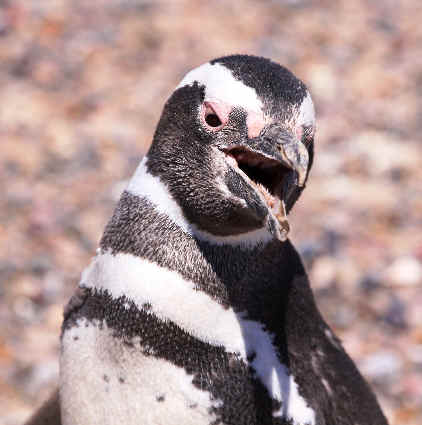
Above: a Magellanic Penguin
during the FONT tour
in Argentina in December 2013.
Below: a beach full of Magellanic Penguins
during that same tour
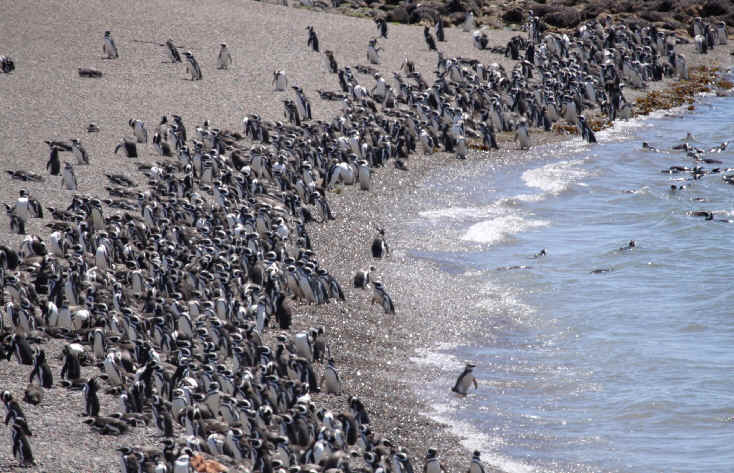
Links:
FONT E-News, April 24,
2015: Going to Iceland - for Nature, Birds, and many of them,
Puffins
FONT E-News, January 15, 2015: Looking forward to Tours in 2015, our 25th Year
FONT E-NEWS, March 15, 2014: Birds & Other Nature during the FONT March 2014 Texas Tour
FONT E-News, February 10, 2014: Some Good Birds Indeed during the FONT 2014 Japan Winter Tour
FONT E-News, December 27, 2013: Birds & Mammals during the FONT Argentina Tour in December 2013
FONT E-News, November 24, 2013: Birds, Nature, Culture during the FONT 2013 Fall Tour in Japan
FONT E-News, August 6, 2013: Birds, Mammals, Butterflies during the FONT Panama Tour, July 2013
FONT E-News, July 29, 2013: Birds, Whales, Moths, & more during the FONT Ecuador Tour, July 2013
FONT E-News, June 27, 2013: Birds, Mammals, & more during the FONT Alaska Tour, June 2013
FONT E-News, May 5, 2013: Birds during the FONT Ecuador Tour in April 2013
FONT E-News, April 15, 2013: Birds with the Longest Wings & the Biggest Talons
FONT E-News, March 4, 2013: Rare Birds & a New Bird now Named
FONT
E-News Bulletins in 2012 & 2011 Earlier
FONT E-NEWS Bulletins in 2011
This last links are to E-News
relating to: Iceland, Puffins, Brazil, the very rare Forbes's Blackbird, the
very rare Northern Muriqui, Belize, Japan, the Dominican Republic, Costa, Rica,
and Chile & a newly-found
Storm-Petrel.
Also to: Bird Taxonomy Updates, referring to Murrelets and
More.
A Chronological List of Upcoming FONT
Birding & Nature Tours
FONT Past Tour
Highlights Narratives & Photo Galleries relating to Past FONT Tours
![]()
FONT E-NEWS, Volume 25, Number 3
April 24, 2015
Going to Iceland - for Nature, Birds, and many of them, Puffins
After his illness and recovery, lasting nearly a year, Armas Hill is now able
once again to travel and lead tours.
And so the first FONT birding and nature tour in a while will be June
5-14, 2015, to a place that over the years has been one of our
favorite destinations - ICELAND.
The tour in June 2015 will be the 20th FONT tour in
Iceland, all led by Armas.
Here, now let's take a look back, with a short narrative relating to
the 10th Iceland Tour for FONT. It was in late
May and early June 2003.
Following the narrative, there are links to the itinerary for
Iceland in June 2015 and to photo galleries from some of the other FONT
Iceland tours in the past.
As of now, there is still some availability for our June
2015 Iceland Tour, but just a place or two remain.
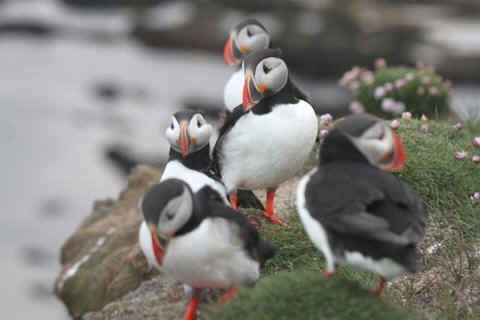
Puffins in Iceland
ICELAND
- with a Solar Eclipse, and Gyrfalcons and Goldcrests
Our 10th FONT birding tour in Iceland
ended on June
3, 2003.
It was the first of two tours there in the late-Spring
2003.
All of the birds that we had hoped for were seen, and more!
The morning of the last day in May, in
one of our favorite Icelandic fishing towns, Stykkisholmur,
began with a sunrise at 330am.
We were up, as it was not an ordinary sunrise that day.
As the large, orange ball near the horizon was going higher, the shadow of the
moon began to cross it. Think of an orange half, then a crescent sun.
Due to the eclipse's path being by the Arctic Circle, the moon's
shadow moved across the sun in the direction opposite that of "normal
solar eclipses".
The approximately 3-minute period of totality was just after 4am.
During that period, the sky was darker than it had been just after 3am.
In 2003, there would be two solar
eclipses, the one that we saw over the Arctic,
and another to be late in the year over the Antarctic.
Our Icelandic experience was the 5th solar eclipse, during a FONT
birding and nature tour, since 1991. The others had been in Costa
Rica, Bolivia, Venezuela, and Turkey.
In Iceland, during our May-June
2003 tour,
not only was there nature in the sky with the eclipse, but also we
visited a place where the Mid-Atlantic Rift, usually beneath the ocean
floor, can be experienced at the surface of the land.
It's a nearly unique occurrence. Along the Mid-Atlantic Rift, the North
American and European Continents are ever so slowly drifting apart. As we were
there, at a rocky, rushing stream, there was a striking male Harlequin Duck.
Interesting, actually, as the Harlequin is one of 2 species of duck,
predominately American, that occur in Europe only in Iceland. The other is the
Barrow's Goldeneye.
One of our most-exciting times during
this Iceland tour was by another rocky stream, out in some vast open
countryside. Just below a waterfall, the stream went through a deep, rocky
gorge.
From one side of that gorge, we had a telescope view that nearly filled the
frame, of a light-colored, female Gyrfalcon on a ledge, next to 2
fluffy, white Gyrfalcon fledglings. It was a sight never to be
forgotten.
Later that day, we were walking in an
Icelandic forest of mostly short conifers.
In recent decades, there have not been many forests in Iceland, but there are
some, and actually now more and more.
In that forest that day, when we were there, Icelandic Redpolls and Redwings
(a European thrush) were common.
But there were also the high, wispy sounds of another bird, Europe's smallest,
the Goldcrest, one of the kinglets. Close to us. We saw one with
the gold crest, and then another fluttering, just learning to fly.
What bird is smaller than the Goldcrest? A baby Goldcrest.
The species was found to breed in Iceland only as recently as 1999.
A couple days earlier, we had seen
Iceland's largest bird, a female White-tailed Eagle on its nest. The
male stood, in the open, on a nearby ledge.
The pair was on a rocky island on a big bay.
We saw the birds during a wonderful boat-ride during which we also saw
thousands of Puffins, on clifftops, on the surface of the water, and in
flight.
Other North Atlantic alcids we saw comparably well during the tour.
When we were standing on a clifftop, during another sunny day, we looked down at Fulmars (many of them) sitting on their nests. Further down, on the surface of the ocean, we saw Great Skua feeding on a floating carcass, Red-throated Loons, and many, many Eiders.
A few miles further, along a dirt road, we had the best possible look at a pair of Rock Ptarmigans, the mostly-white male with bright red eyebrows. The brown female blended in with the terrain. Both were just outside the windows of our van.
Further along, during our ride, were Red-necked
Phalaropes, also close, spinning around on roadside pools.
After passing through one of a number of Arctic Tern colonies, we saw,
in a stony area, some nice Snow Buntings in breeding plumage.
Along another road that day, in an area
of meadows, we had a close encounter with a Short-eared Owl, as more Snipe
than imaginable were winnowing in the sky. At one time, 14 snipe were
counted above us.
Ravens flew by, adding their sounds to the mix.
Over 70 species of birds breed in
Iceland. We saw nearly all of them.
The list of avian vagrants in Iceland is long, and we came across a
couple of them: Great Crested Grebe and Grey Heron (the heron
occurs more normally in Iceland in the winter).
Migrant birds that were still on their way farther north, yes further north,
included some shorebird flocks with Turnstones, Sanderling, and Red
Knot.
Another bird that we were fortunate in
May to see in Iceland was the Iceland Gull. That species actually
nests, not in Iceland, but further north in Greenland.
Now, here are the links, as promised, to:
The Upcoming June 2015 FONT Iceland Tour Itinerary
and:
Some Highlights and Photo Galleries from other previous FONT Iceland
Tours
Also links for: Iceland Birds Iceland Wildflowers
![]()
FONT E-NEWS, Volume 25, Number 1
January 15, 2015
Looking forward to Tours again, in 2015,
the 25th Year for Focus On Nature Tours
Back in June
2014, shortly after our FONT tour in May in southern and western Ecuador,
Armas Hill, who led that tour and many over the years, made what he thought
would be a routine visit, when back home, to the dentist.
However, an x-ray showed that something was wrong, with an image above the
teeth that should not have been there.
A biopsy in July confirmed the problem, and during that month, and then in
August, Armas had 4 surgeries, with 2 of them major but all of them important.
Afterwards, in October and November, he underwent 6 weeks of radiation
treatments and chemotherapy.
The good news during the summer was that with the cancer there was no
metastasis, and that the scans indicated no further spreading of the disease.
Recovery from the surgery has been as it was expected to be, but recovering
from the treatments has taken longer than Armas preferred, particularly in
relation to the sinuses, which had to be treated in order to be sure that
microscopic traces had not settled there.
A fine medical team had told Armas that indications were that he would be
cured, but getting there would take months, as it has, into December and then
now into January 2015.
Those same doctors also said that Armas will be well enough to lead tours
again, as he is now ready to do, in the spring of 2015.
So, his 25th year of doing FONT birding and nature tours will get a bit of a
late start, but start it will.
![]()
FONT E-NEWS, Volume 24, Number 3
May 22, 2014
A Variety of Birds in Ecuador in April/May 2014
and a mammal with the longest tongue for any mammal its size
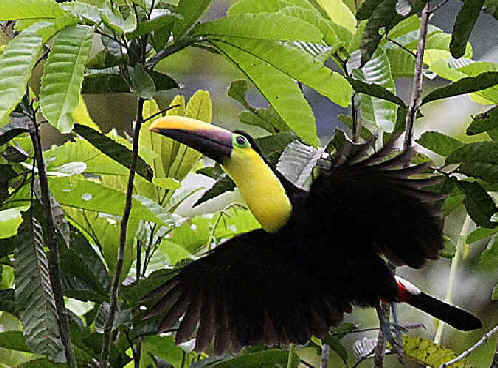
One of the more than 250
species of birds during our April-May 2014 tour in Ecuador,
the Chestnut-mandibled Toucan
(photo by Marie Gardner)
Our 21st
FONT tour in Ecuador, in late-April
and early-May 2014, was in the southern
and western parts of the country.
We were, at various times during the tour, high in the Andes
Mountains, at sea level by the Pacific
Ocean, and at a number of elevations and habitats in between.
The over 250 species of birds found during the tour were also
quite varied.
Among them, there was a large antpitta, that was discovered only about 15
years previously, with a nifty Ecuadorian name, the Jocotoco Antpitta.
One morning, we saw it well.
That same morning, we heard a tapaculo that was described the same year when
the antpitta was found. Called the Chusquea Tapaculo (another unusual
name), it is scientifically called Scytalopus parkeri.
Among reasons why the Jocotoco Antpitta was not discovered until
"rather late", is that it is a rare bird with a very limited range
in the remote southern Ecuadorian forested highlands. That range is but a
"dot on the map".
Another bird during our tour also with a range that's a "dot on the
map", and also rare, actually very rare, was the Pale-headed Brush
Finch.
Only a few years ago, a mere 20 breeding pairs were known to exist. Due to the
efforts of a conservation group in Ecuador, that very small population is said
to have increased three-fold, now up to about 60 breeding pairs. That
"conservation group" in Ecuador is the
Jocotoco Foundation, named the same as the antpitta.
The foundation has established reserves in the country protecting those
two species, and others, as well as natural habitat that would most likely
otherwise be lost.
Along the seacoast, actually right along
the seacoast at the surf on the beach, there was an experience that was
"right up there" among the best during the tour.
A tight flock of Blue-footed Boobies were flying, and diving, just
offshore. There were at least a couple hundred birds. In groups, they dove
like bullets into the water. When they would rise, they would circle about,
and dive again, and again. There must have been schools with many small fish
in that water, for there to have been such a sight above the surface of the
sea.
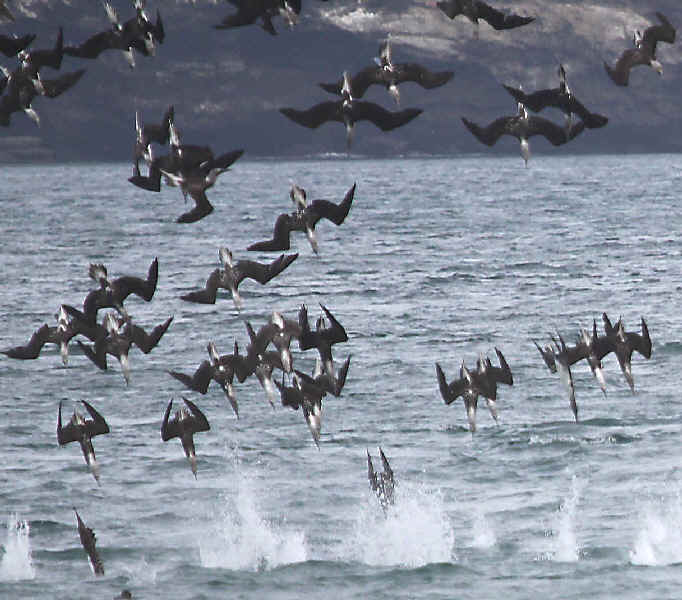
Diving Blue-footed Boobies
during the FONT Ecuador Tour in May 2014
(photo by Marie Gardner)
The previous day, at another coastal spot, there were also many birds, with
clouds of Magnificent Frigatebirds floating in the air, and dozens of
attractive Gray-hooded Gulls on the beach.
Seaside birding is great, anywhere.
During our two previous Ecuador tours, prior to this one, in
April and July 2013, collectively over 50 species of hummingbirds
were seen.
How nice it was that during our April/May 2014
Ecuador Tour, yet another 13 additional species were observed.
Those seen in 2014, not seen in 2013, were: Pale-tailed Barbthroat, Green
Hermit, Violet-headed Hummingbird, Wire-crested Thorntail, Fork-tailed
Woodnymph, Violet-fronted Brilliant, Black-throated Brilliant, Rainbow
Starfrontlet, Amethyst-throated Sunangel, Flame-throated Sunangel, Black-eared
Fairy, Long-billed Starthroat, and an undescribed subspecies of the "Loja
Hummingbird" in southern Azuay province.
Most of these additional hummingbirds were seen at a place we particularly
enjoyed in far-southeastern Ecuador, on a lower Andean slope with an
Amazonian tint. That place is called Copalinga,
where in addition to the hummingbirds, we enjoyed some colorful tanagers,
including the Paradise, Green-and-gold, and Golden-eared, along
with orodendolas, caciques, two species of jays (Violaceous
and Inca), Red-headed Barbet, and a bird not commonly seen
there, a Rufous-tailed Tyrant.
Before daybreak, one morning at Copalinga, we heard two Band-bellied Owls.
To the 4-part list of Ecuadorian birds in the FONT website, we've added the
code "CP", noting species that occur at Copalinga.
To see the listing: ECUADOR BIRDS
Another place we enjoyed in 2014,
but as we did in 2013, was a Jocotoco foundation reserve called Buenaventura. There, this
time, we couldn't help but enjoy the half-dozen plus Swallow-tailed Kites
that soared about by us, sometimes at eye-level, above green forested hills in
the background.
Near that reserve, we saw 2 Bat Falcons, a male and a female, perched
in the same dead tree where we had seen them the previous year. The next day,
however, we didn't see them, in that same tree.
As said earlier, there was a varied assortment of birds during the
April/May 2014 Ecuador Tour.
There were two species of chachalacas.
There were birds as big as the Horned Screamer and as small as the Club-winged
Manakin.
Groups of Chilean Flamingos were on pools along the coast.
And there were some other rare, or threatened birds in addition to the
Jocotoco Antpitta and Pale-headed Brush Finch. Both of those
species are categorized by Birdlife International as "endangered".
Birds that we saw, categorized as "vulnerable" included the Bearded
Guan, Golden-plumed Parakeet, and the Saffron Siskin.
There's a link below to a list of the more than 250 species of birds found
during the FONT April/May 2014 tour, as
noted in southern and western Ecuador,
from the mountains to the coast.
Links:
Birds during the FONT Ecuador Tour - April-May 2014
A
Photo Gallery of Birds, Scenery & Culture during
the April-May 2014 FONT
Ecuador Tour
A Photo Gallery of Moths & Butterflies during some FONT Ecuador Tours
And an interesting mammal was seen during the April-May 2014 FONT Ecuador Tour
in the southern part of the country.
At the same reserve, Tapichalaca, where the
Jocotoco Antpitta was seen, there
was after dark, the Tube-lipped Nectar Bat, Anoura fistulata, coming to the
hummingbird feeders that had been so active during the day with hummingbirds.
That species of bat, Anoura fistulata, was described to science only as
recently as 2005, eight years after the Jocotoco Antpitta was described, and
less than 10 years before our tour.
It inhabits subtropical Andean forest, between about 3,000 to 6,600 feet above
sea level, geographically where we were.
It is said to be endemic to Ecuador, but Peru is not far away.
The long tongue of Anoura fistulata is similar, in its anatomy, to that of an
anteater.
And that bat has what is said to be the longest known tongue of any mammal in
the world in relation to the size of the mammal. The tongue goes as far into
the animal as its ribcage. The length of bat is 2 inches. The length of is
tongue is 3 and a half inches.
As fast as hummingbirds can be, when they visit feeders, the bats even seemed
to be faster. And of course they made their ever so-quick visits in
darkness.
But even so, the photo below, taken during our tour, shows the bat and part of
its long tongue, and provided the identification.
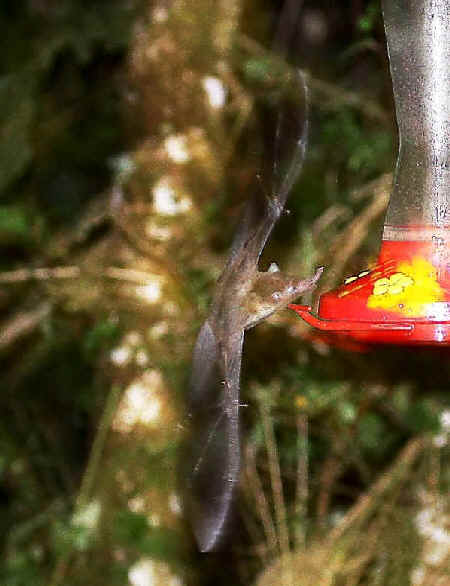
A Tube-lipped Nectar
Bat during the April 2014 FONT tour
in southern Ecuador
(photo by Marie Gardner)
![]()
FONT E-NEWS, Volume 24, Number 2
March 14, 2014
Birds & Other Nature in Texas in March 2014
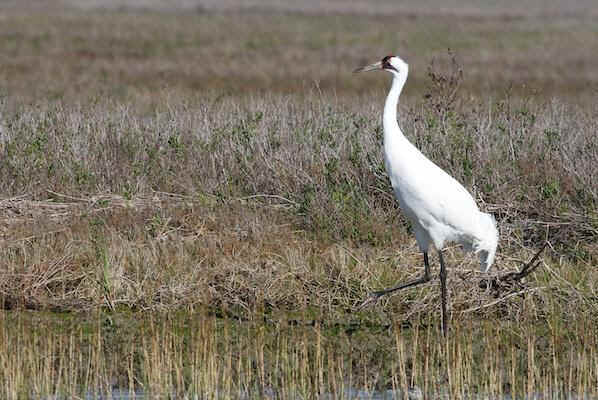
One of the endangered
Whooping Cranes at the Aransas Refuge
(photo by Marc Felber)
Our tour in March
2014, in central and southern Texas,
was scheduled for us to see two special and rare birds, both categorized as endangered, the Whooping Crane and the Golden-cheeked
Warbler. And that we did.
We enjoyed a fine, and close look at a pair of Whooping Cranes during
the first full day of the tour, at the Aransas
National Wildlife Refuge, along the Gulf
Coast, where what has been the only wild flock of them has wintered
for years.
Our encounter with the Golden-cheeked Warbler was in the "Hill
Country" of Texas, where we saw and heard them, during the
last full day of our tour, and the first day when the species was found there
in 2014, at the Lost Maples Natural Area,
a prime place for that specialty bird that only breeds in that region of
central Texas.
It spends its non-breeding season south of the US-Mexico border, mostly in
Central America. We've seen it during FONT tours in Guatemala and Honduras,
mostly in Honduras.
Another "good bird" for us in the "HIll
Country" of central Texas was a Hutton's Vireo. We
watched it sing. That species is most often seen and heard in Texas further
west in the Trans-Pecos region.
During the days between our first and last full-days of the tour, we saw a
number of other birds that were good to see, including: Green Jay,
Audubon's Oriole, Pyrrhuloxia, Greater Roadrunner, Vermilion Flycatcher,
Verdin, Great Kiskadee, Rufous-crowned Sparrow, and Harris'
Sparrow, just to name a few.
We also enjoyed seeing Sandhill Cranes, Roseate Spoonbills, Northern
Crested Caracaras, and an Aplomado Falcon.
"New" for FONT tours in Texas were: American Golden Plover,
White-winged Scoter, and Lesser Black-backed Gull.
At the end of the March 2014 Texas Tour,
our cumulative list of birds found during FONT tours in that state topped 400
species.
Also, when in Texas, in addition to the birds and other nature, we also
had some very nice times with people, at the various places we went, but
especially one evening when we had a joint-dinner with participants who were
on a previous FONT tour a few years back. That evening was when we were with a
number of the people of the Wimberley Bird Society
who were on the FONT tour in Iceland in
June 2009. It was great to be with them.
Others with us in Texas in March
2014 were previously with FONT on tours in Alaska,
Spain, the Canary Islands, Guatemala,
and another Iceland tour.
Links:
More
about the FONT Tour in Texas in March 2014
Birds
& Other Wildlife during our Texas Tour in March 2014
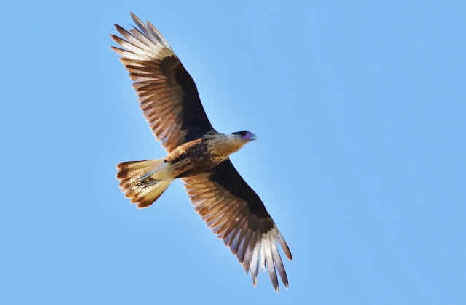
A Northern Crested Caracara
in flight,
photographed in Wimberley Texas,
a place we visited during our March 2014 Texas Tour
(photo by Rhett Poppe)
The Northern Crested Caracara was a
species
seen nicely during the first day of that tour,
less than 15 minutes south of the airport in Austin.
![]()
FONT E-NEWS, Volume 24, Number 1
Some Good Birds & More in Japan in January-February 2014
The FONT
Japan Winter Birding & Nature Tour in January
& February 2014 was our 37th tour in that country and our 24th
there during the fall & winter seasons.
During our tour, 145 species of birds were found, as we travelled on 4 Japanese
islands: Honshu, Hokkaido, Kyushu,
and Amami.
The northernmost of those islands, Hokkaido,
was, as it always is during January & February,
the most wintry, with snow and cold temperatures.
But also, again, as has been the norm during this tour, there were, in the
setting there of spectacular scenery, some special birds including dozens of
both Steller's Sea Eagles and White-tailed Eagles along the
seacoast, Red-crowned Cranes in a flock as they called and danced on the
snow, and Whooper Swans also calling as they were on the open water of an
otherwise frozen lake.
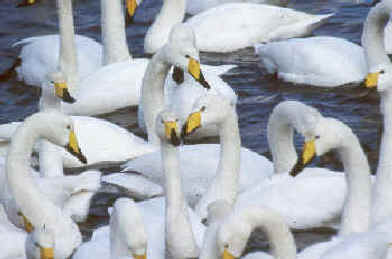
Whooper Swans in Hokkaido
(photo by Alan Brady, during a previous
tour)
This tour was dedicated to our good friend
Alan.
He passed away the day before it began.
Elsewhere on Hokkaido, at a place with a hot spring and Japanese bath, by a
fast-flowing stream in a snowy woods, a little wren walked at the water's
edge. Also there, a very attractive animal, a mostly orange-colored Japanese
Marten was in view as the big Blakiston's Fish Owl repeated its deep
call, at dusk, from up in the trees.
While on the more southerly island of Kyushu, we saw
Saunder's Gulls and
Black-faced Spoonbills along the coast. Both are rare birds, and both come from
mainland Asia, visiting Japan in the winter.
The Saunder's Gull comes from
China; the Black-faced Spoonbill most likely from Korea.
The next day, in reeds, two other species that are nice to see were enjoyed, the
Chinese Penduline Tit and the Pallas' Reed Bunting.
Not far from them, were flocks of thousands of White-naped and Hooded
Cranes.
Among nearby Rooks, there was the Daurian Jackdaw.
All these species also come from mainland Asia, to be in Japan in the
winter,
We had come, of course, to be in Japan in the winter, but we came from places
even further away. Some in our group came from Holland, some from England, while
one of us (me) came, of course, from the eastern US.
Another bird came to Japan from mainland Asia with the adjective "Daurian"
in its name.
The male Daurian Redstart was one of the most attractive of the
smaller birds during our tour.
Rare in Japan on Kyushu was a species more likely to be in mainland Asia, the
Forest Wagtail.
The Japanese name for that bird is "Iwani-sekirei" which means
"sideways-swinging wagtail", and is that what bird does.
Photographers had set food for it on two stumps, with a horizontal stick in
between. The bird came in, and walked back and forth on that stick with its
distinctive swaggering, sideways-swinging walk.
As it was on on one of the two stumps, an attractive male Daurian Redstart was
on the other.
The Forest Wagtail was a first for FONT tours in Japan, making 397 species
cumulatively found during our 37 tours.
On the southernmost island during our tour, Amami,
we had very nice looks at one of the endemic and specialty birds, the Amami,
or Lidth's Jay. That bird is endemic not only to Japan, but actually to
Amami and one small adjacent island.
Considered subtropical, Amami is a green island, with forested hills.
During our stay there, other birds that we we encountered included 3 species of owls,
the Black Wood Pigeon, the Ryukyu Robin, a single Solitary
Snipe (not to be redundant), 4 species of plovers on a single beach
where offshore a Brown Booby flew, Pacific Reef Herons on seaside
rocks, and both the Amami and the White's Ground Thrushes.
Ending the tour, a beautiful little turquoise jewel sat streamside, a Common
Kingfisher. No matter how common, it's always a nice bird to see - and were
many of the birds during our January-February 2014
Japan Tour.
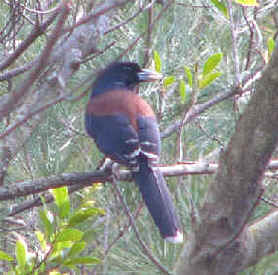
An Amami, or Lidth's Jay,
photographed during a previous FONT tour.
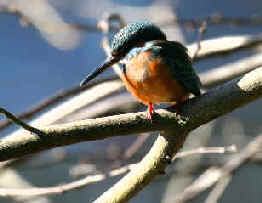
The Common Kingfisher
Links:
More about the FONT Japan Tour in January-February 2014
Birds & Other Wildlife during FONT Japan Tour in January-February 2014
![]()
FONT E-NEWS, Volume 23, Number 10
December 27, 2013
Birds and Mammals in Argentina in December 2013
From many places in the world, and from where most of us live, the region of Patagonia in southern South America is long distance away, thousands of miles, or thousands of kilometers, regardless one measures.
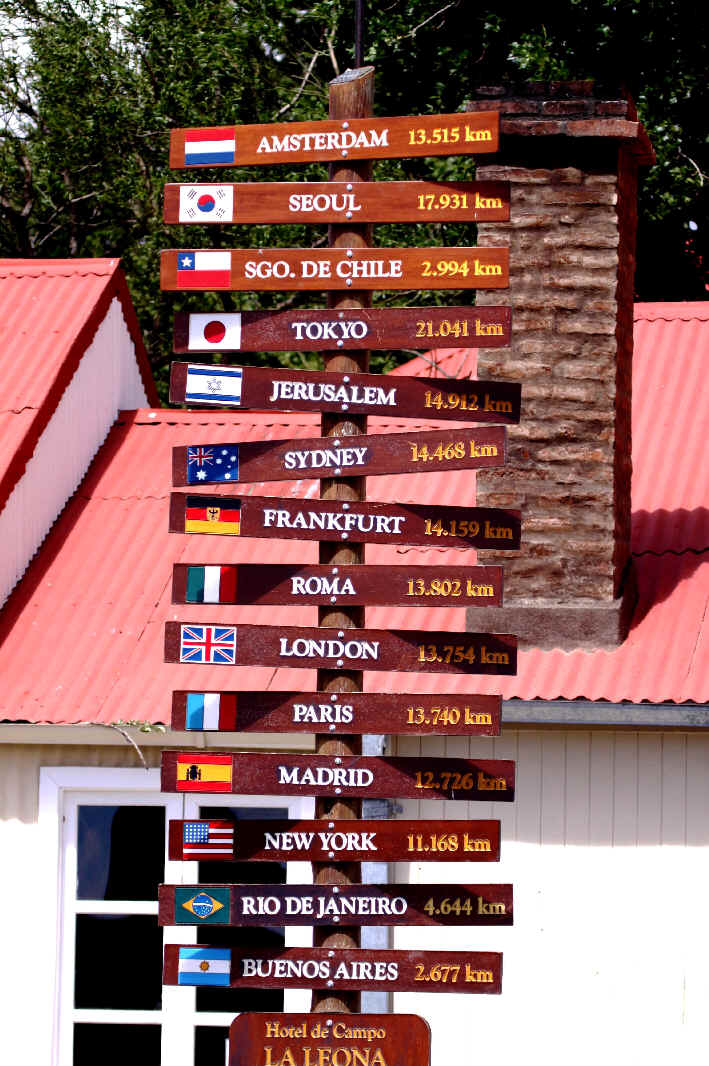
As the sign indicates, only
Buenos Aires in Argentina
and Santiago in Chile are relatively close.
And that far-away place, known as Patagonia,
is different than others that most of us know.
It is vast. Much of it, in what is known as the steppes, is treeless.
It is often windy, sometimes very windy.
Roads, some of them dirt and gravel, seem at times to be endless. Along those
roads, between small towns and between junctions, there is often no sign of
people.
In Argentina, we're told, that one of every three people live in and near the
capital city of Buenos Aires, by far the largest city in the country. Somewhere
else, the second largest Argentine city is not large at all.
A vast country Argentina certainly is, and its southern region of Patagonia is
about as unpopulated as it gets, and seemingly empty.
But yet it is a good place to see nature, with especially birds and animals
not to be found elsewhere.
And among them are some that unique and special.
And many of those birds and mammals we saw during our December
2013 Southern Argentina Tour, either where there was some truly
dramatic scenery as where the treeless plains meet the forested slopes of the
high, rocky and snowy peaks of the Andean mountains, or along the also-dramatic
and picturesque seacoast, and in between in that land seemingly with nothing.
153 species of birds were found during our tour. Some, such as the Masked
Duck and the Masked Gnatcatcher, and the Southern
Yellowthroat (formerly the Masked Yellowthroat) were seen only in Buenos
Aires. Yes, a Masked Duck was seen in the heart of that
bustling city.
But most of our bird species were found in Patagonia.
There were those that were "Magellanic", including the unique Magellanic
Plover (that's not really a plover), the Magellanic Penguin (we saw
thousands), the Magellanic Oystercatcher, Magellanic Woodpecker,
and Magellanic Tapaculo.
Also, the Upland Goose, that we commonly saw, has also been called the "Magellan
Goose", the attractive Dolphin Gull has also been called the
"Magellan Gull", and the Rock Shag, or Rock Cormorant,
has been called the "Magellan Cormorant".
Magellan (that is the explorer Ferdinand Magellan) came from
far-away to Patagonian oceanic waters, years ago, in the early 1500s, when he
and his crew were the first to circumnavigate the globe.
And there were birds during our tour that were "Austral",
including the Austral Rail (a species only found a very few times during
the entire 20th Century). the Austral Parakeet (the southernmost parakeet
in the world, yes where we were in Patagonia was further south than New
Zealand), and the Austral Canastero, the Austral Thrush, the Austral Blackbird, and the Austral
Negrito.
The last of these, a dapper little flycatcher, commonly seen and often out in
the open, has had some other common names: the Patagonian Negrito, or, as
it was known for years, the Rufous-backed Negrito.
The adjective "Austral" means "southern", as
in "Australia", but where we were in Patagonia was again further
south.
Birds during our Southern Argentina Tour in
December 2013 included: tinamous (seen often), rheas, swans
(2 species), geese (2 species), ducks (15 species), a penguin
(only 1 species, but thousands of them), a giant petrel, grebes (4
species), a flamingo, ibises, egrets, cormorants (or
shags), a condor, falcons, such the Aplomado, and
other raptors, and rails, gallinules (2 species), coots
(3 species), oystercatchers (3 species), plovers including the
very attractive Tawny-throated Dotterel with young, some shorebirds
(away from the shore), gulls, a tern, a skua, pigeons
and doves, parakeets and the Burrowing Parrot, a cuckoo,
an owl, a nightjar, hummingbirds, woodpeckers, flycatchers
(including some not often seen such as Chocolate-vented Tyrant and the Hudson's
Black Tyrant), furnariids including a miner, earthcreepers,
cinclodes, hornero, rayadito, canasteros, and a treerunner).
Also, martins and swallows, a wren, gnatcatcher, mockingbirds
(3 species), thrushes (4 species), pipits (3 species), siskins
(2 species), various icterids, a sparrow (that seemed to be
everywhere), a cardinal, a tanager, seedeater, yellow
finches (2 species), sierra finches (3 species), and a warbling
finch.
3 of the bird species seen during our tour are flightless: the Chubut
Steamer Duck (a localized Argentine endemic and a globally threatened
species), the Magellanic Penguin, and the Lesser Rhea.
The subspecies of the last of these in southern Argentina is also called the "Darwin's
Rhea". In the 1800s, Charles Darwin went to Patagonia, like
others and like us, from a long way away.
Along one of the dirt roads during our tour, on the Valdes
Peninsula, one morning we truly had quite a sight in front of us. We
counted as many as FIFTY Lesser Rheas. One was an adult. All of the
others were youngsters, some larger and some smaller. Male Rheas raise the young
from a few different females. But, again, seeing just the one adult with 49
young Rheas running about was something extraordinary.
We also saw young of other birds during the tour as December was
"that time of year", spring in the Southern Hemisphere.
Such youngsters included those of the Upland Goose, Crested Duck, Black-faced
Ibis, Southern Lapwing, Two-banded Plover, and those, already
mentioned, of the Tawny-throated Dotterel. And of course those of the Magellanic
Penguins, as fluffy as they were.
But only was that one Lesser Rhea with so many, nearly 50, little ones.
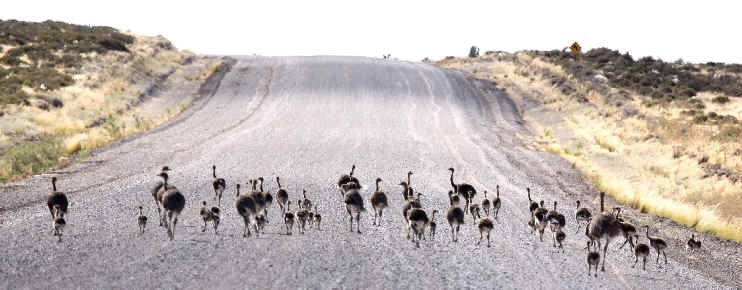
The 50
Darwin's, or Lesser Rheas on the road in front of us
during the December 2013 FONT Southern Argentina Tour
Mammals during the tour included: many Guanacos (a cameloid), the
Mara (an odd mammal, indigenous to where we were in Argentina), the Small
Patagonian Cavy (called locally the "cuis"), the Magellanic
Tuco-tuco, the Big Hairy Armadillo (actually better-looking than
its name sounds), the Patagonian, or Humboldt's Hog-nosed Skunk,
the Lesser Grison, 2 species of Fox: one called the Colpeo
(or Zorro Colorado) and the South American Gray (Zorro Gris), and 2
species of wildcats: the Pampas Cat and Geoffroy's Cat.
We saw more Guanacos than imaginable, including one chasing a hare
(the European Hare, introduced and now very common in Patagonia).
Along the seacoast, we saw colonies of South American Sea Lions and Southern
Elephant Seals. At one place, we were able to sit close to the elephant
seals. Generally docile, they lay on the sand of the beach, sometimes making
sounds hard to describe (at least pleasantly).
Of course, later we would go, by plane, thousands of miles away. I thought of
how those seals would swim, later, hundreds of miles away or more, and
dive into the ocean to depths of thousands of feet. Routinely, they dive
to about 3,000 feet beneath of the surface of the sea for squid and fish. They
have been known to dive as deep as 7,000 feet below. No mammal in the world
dives deeper.
From an overlook, along the coast, we saw an Orca, or Killer Whale
in the surf.
In all, we saw 15 species of mammals during our December
2013 Southern Argentina Tour, with nearly all of them as with the birds,
creatures that one had to be where we were in order see them, in a
seemingly-empty place called Patagonia.
Links:
More about the FONT Argentina Tour in December 2013
A Gallery of Photos from our December 2013 Argentina Tour
List
of Birds & Other Wildlife during the FONT Argentina Tour - December 2013
![]()
FONT E-NEWS, Volume 23, Number 9
November 24, 2013
Birds, Other Nature, and Culture in Japan in October-November 2013
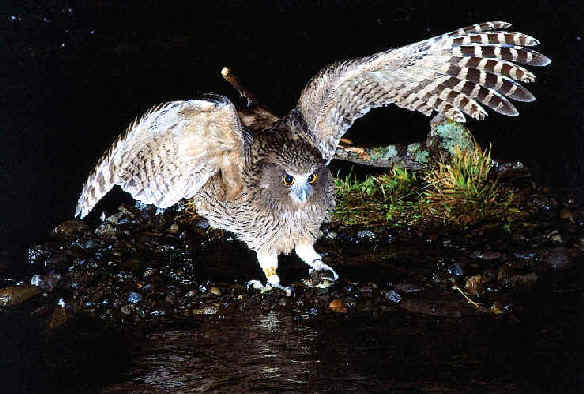
The Blakiston's Fish Owl as
we saw it during our Japan Tour in November 2013.
Our FONT
2013 autumn tour in Japan was filled with things to be remembered,
and among the most memorable were big, rare Blakiston's Fish Owls,
close to us at a stream (we saw 3), and stately Red-crowned, or
Japanese Cranes, known as "Tanchos" out on
fields, so nice to see as they walked about. These owls and cranes
were on the northern Japanese island of Hokkaido.
On the main Japanese island of Honshu,
never to be forgotten were the brilliant colors of the trees in the
mountains. Beneath fresh snow on peaks up to about 10,000 feet above
sea-level, the fall foliage was an incredible profusion of reds,
oranges, and yellows. The forests on the slopes were ablaze with color.
In that marvelously scenic area called the "Japanese
Alps", we rode a gondola to be as high as we could be.
Then, getting away on a trail, from the others who had taken the same ride, we were
in a wonderful forest of conifers, where we looked eye-to-eye with a bird
endemic to Japan, the Japanese
Accentor, and later a Spotted Nutcracker perched nearby on a treetop.
At the classy Japanese inn where we stayed, nestled among snow-topped
mountains and surrounded by the incredible bright foliage, and where we ate
and slept "Japanese-style", there were, in the morning, outside the
door, more nutcrackers
and a large flock of Bramblings that had just arrived from further north.
A gondola was just one of many ways we traveled during the tour. We
were, on the ground, in four different hybrid vehicles, a couple taxis,
a skinkansen (or "bullet train"), while in the air, we
were in a plane from Honshu to Hokkaido, and at sea on a large ferry,
going overnight from Hokkaido back to Honshu.
During our morning on that big
boat, after the sun rose in the "land of the
rising sun", as Japan is called, we saw seabirds all
morning, with thousands of Streaked Shearwaters and other pelagic birds including 2 species of Albatrosses, the Black-footed and
the Laysan, along with jaegers and gulls. Among the
latter, there were kittiwakes.
We saw two pods of Pacific White-sided Dolphins swimming quickly in the
water. As rapid, or even more so apparently, were the Pacific Blue-finned
Tuna being chased by the dolphins. One big tuna leaped completely out of
the water.
Mammals seen on land during our October-November
FONT Japan Tour included Red Fox, Sika Deer, Raccoon Dogs
(3 of them seen well), and the Japanese Macaque, or "Snow
Monkey".
Butterflies during our autumn tour in Japan, even as late as the end of
October and early November, included: Nepargynnis anadyomene (a fritillary),
Polygonia c-album hamigera, the race in Japan of the Eurasian Comma,
Goenpteryx aspasia, the Common Brimstone, and Pieris
brassicae, the Large White.
The last of these, a close
relative of Pieris rapae that we know in the US as the Cabbage White,
was seen along the seacoast of the northern island of Hokkaido, even as late
as in November.
In all, we found 122 species of birds on Honshu
and Hokkaido during our October-November
2013 tour in Japan, during
which there were also innumerable "Japanese experiences" for
us, including:
sushi, tea, various footwear, onsens (hot springs), ryokans
(Japanese inns), temples, rice fields, bonsai, and the gardens
where we saw some of our birds.
Near where we saw the Red-crowned Cranes, a young Japanese lady gave us
an "origami", a small paper replica of yes, the crane.
It was just one of the nice moments during our tour.
Links:
More about the FONT Japan Tour in October-November 2013
Birds & Other Wildlife during FONT Japan Tour in October-November 2013
The following
commentary was received at FONT by e-mail following our Oct/Nov 2013 Japan
Tour by one of the participants:
"Hi Armas,
Your autumn 2013 Japan tour was a very interesting trip for me. I very much
enjoyed interacting with the Japanese people, and the country.
I have many great memories of a wonderful adventure.
Your knowledge of the birds and fauna is very impressive.
I hope you and your family had a good Thanksgiving and will have a very Merry
Christmas and Happy New Year."
Robert Dix
Texas, USA
![]()
FONT E-NEWS, Volume 23, Number 8
October 10, 2013
Birds and Other Nature in Iceland in September-October 2013
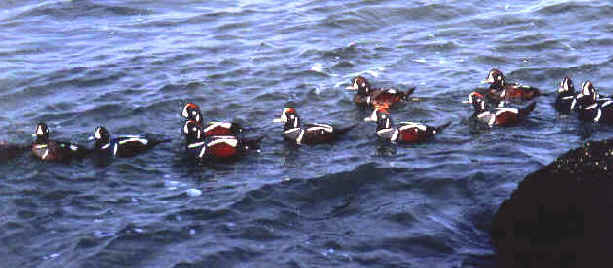
A string of male Harlequin
Ducks
The FONT
Fall Tour in Iceland in September/October
2013 was our 19th birding & nature tour in that country.
Even though there have been that many FONT tours there in the past, during
both September/October and May/June, this tour was different than any other.
We traveled the circumference the island, along the
"ring road", during our week or so in Iceland. We've done
that previously, so that's not different. But again, it was a great way to see
"so much" of Iceland.
And, as we did, we had a wonderful time. And once again, that's not different
than during our previous Iceland tours, as we've had wonderful times in the
past.
But, along the way, we went to some interesting and scenic places, not visited
during previous tours, as we saw and experienced such a mosaic of colorful
and striking scenery, fascinating geology, seascapes, tundra, glaciers,
waterfalls, thermal sites, good Icelandic food and culture, along
with of course the birds and other nature.
62 species of birds were seen during the tour. Of them, 6 were "new
species" for FONT in Iceland, bringing our cumulative total to 110
species.
Among the 62 species, 11 were gulls, including, as we were
having lunch by a harbor in a picturesque small fishing village, a Sabine's
Gull and 2 Little Gulls together with the more numerous gulls,
mostly Black-headed, while later that day, at another place, on glacial
icebergs, with other gulls, including Iceland, and again mostly Black-headed,
there was a completely "new species" for Iceland, a first-winter Mediterranean
Gull.
Among the birds most enjoyed during our tour were the flocks of Common
Eiders, Barrow's Goldeneyes, and Harlequin Ducks, as well as those
of Whooper Swans, along with 3 species of alcids, including, for
the first time for us in Iceland, the Dovekie, or Little Auk,
and 2 species of godwits: the Black-tailed Godwit, an
brightly-colored subspecies endemic as a breeder to Iceland, that was
about to leave the island, while the Bar-tailed Godwit, a non-nester in
Iceland that had just arrived from Norway.
Especially enjoyed was the strikingly beautiful Long-tailed Duck, a
bird now classified by Birdlife International as a "threatened
species".
Two "Icelandic Wrens" near us as they popped in & out of
a rock jetty, along the far eastern Iceland coast, as well as one that sang
its song in a beautiful Icelandic forest, were treats.
Some birds that we've found during our autumn Iceland tours previously
eluded us this time.
For example, we saw not one Snow Bunting.
But we did see more Redpolls that usual, at various places throughout
the island.
Of course, most (actually, nearly all) were Common Redpolls, including
the Iceland endemic subspecies "islandica".
But a couple birds, at the beginning of the tour, were of an interesting race
of the Arctic (or Hoary) Redpoll. Those birds, pale "Greenland,
or Hornemann's Arctic Redpolls" were nearly as white as
snowflakes.
Also, we did not, unfortunately, cross paths this time with a Gyrfalcon,
but during one remarkable scenic ride in northeast Iceland, we did enjoy as
many 5 different Merlins, the other, smaller falcon that breeds in
Iceland.
Also different than during all of our other Fall FONT Tours in Iceland
was that the "Northern Lights", or Aurora Borealis,
was not meant to be.
Such activity in the nocturnal sky in October 2013 was less and more limited
than usual in the Northern Hemisphere, but during our last night, which was
so very clear, we saw stars, from horizon to horizon, and the Milky
Way overhead, for us as "never before". It was truly memorable,
especially as we stood, miles away from any city lights, but right next to a geyser
that periodically lifted a hundred feet or so into the air.
Links:
More
about the FONT Iceland Tour in Sep/Oct 2013
List
of Birds during the FONT Iceland Tour - Sep/Oct 2013
The
following commentary was received at FONT by e-mail following our Sep/Oct 2013
Iceland Tour
from one of the participants:
"Armas,
I want to tell you how much I enjoyed the trip - I couldn't have asked for a
better experience.
With birds, waterfalls, glaciers, geysers, hot springs, fall colors, black
sand beaches, rocky coastlines, and rugged highlands. Plus a few adventures!
Maybe we'll have a chance to travel together again."
Alan
Virginia, USA
![]()
FONT E-NEWS, Volume 23, Number 7
August 6, 2013
Birds, Mammals, Butterflies in Panama in July 2013
Panama
is a small country. 40 of the US states are larger than it. 10 US
states are smaller. The closest US state in size to Panama is South Carolina,
which is slightly larger.
In size, Panama has only 77,381 square kilometers, or 29,762 square miles.
But even though Panama is small, it
has a big bird list, in fact one of the highest lists of lists of birds
of any country in the world, and certainly so for its size.
Nearly a thousand different bird species have been known to occur in
Panama. 975 species are included In the Panama bird-list in the FONT website (link
to it below).
Actually the "official list" for the country is even slightly higher than
that, with 978 species as of 2010.
In all of North America, north of Mexico, and even including vagrants, not
nearly that number of species have been found.
During FONT birding & nature tours in Panama
over the years, nearly 600 species of birds have been tallied.
During our one week-long FONT Panama Tour in July
2013, over 220 bird species were found. That's over 20 per
cent of the total species in the Panama bird-list.
And when it is taken into account that a good chunk of Panamanian birds are
only in western Panama (where we were not), and that a substantial
number of vagrants have occurred in the country, and that about 150 Panamanian
species are seasonal migrants from North America (not there when we were in
July), our number of birds was quite good indeed.
Many of the birds that we found during that tour were in one region,
the Canal Basin, with, in that area, some
prime birding places such as the Pipeline Road,
Gamboa, and the Metropolitan Park
in Panama City.
Birds for us included an assortments in Neotropical groups of
parrots and parakeets, trogons and toucans, motmots
and manakins, wrens, and antbirds.
Even though, as noted, the number of birds in Panama is great,
the number of ants that country is far, far greater, and
so we watched again, as we have in Panama in the past, frenzies of feeding
birds following the masses of ants and other creatures escaping from them.
The avian ant-followers included antbirds of course, and also woodcreepers
and tanagers.
Also during the July 2013 tour, we
ventured further east in Panama, as far
the lowlands in the remote and wild Darien province.
Doing so, we saw a number of birds either restricted to eastern Panama and
Colombia, or birds more "South American" than "Central
American".
In those categories were species such as White-eared Conebill, Black
Oropendola, Green Manakin, Double-banded Graytail, Slate-throated
Gnatcatcher, Spot-breasted Woodpecker, Spectacled Parrotlet, and Orange-crowned
Oriole.
At a very pleasant place, with good accommodations and meals, where we stayed near
the Darien border, we saw not only the just-mentioned Spot-breasted
Woodpecker (a very local bird in Panama) and Spectacled
Parrotlet, but also a nice assortment of hummingbirds.
Mammals during our July 2013 Panama Tour
included: two species of sloths, Kinkajou, Capybara, Coati, Agouti,
Paca, Neotropical River Otter, Crab-eating Raccoon, and every day Howler
Monkeys either seen or heard.
Butterflies were numerous. Among them were Morphos, some bright
blue and others pale, nearly white, along with many other butterflies such as Malachites
and various Longwings and Swallowtails, just to mention a few.
So, during our summertime week in Panama we saw much, and, as we did so, we
had a good time!
Links:
More about the FONT tour in central & eastern Panama in July 2013
A
List of Birds & Other Wildlife during our Panama Tour - July 2013
![]()
FONT E-News, Volume 23, Number 6
July 29, 2013
Birds, Whales, Moths, & More in Ecuador in July 2013

A Great Grebe photographed
during a FONT tour
Our birding
and nature tour in Western and Southern Ecuador in July
2013 was the 20th FONT tour in that country, and our second tour in
Ecuador in 2013.
Highlights during the tour were many, as we observed creatures
from as small as the hummingbird called the Short-tailed Woodstar (2
and a quarter inches) to as large as the Humpback Whale (up to 50 feet
long).
Over 1,100 bird species have been found during the 20 FONT tours in
Ecuador over the years.
235 species of birds were found during our July 2013 tour, with many of them
being "regional specialties".
But 2 species were found during the tour that were NOT in the book,
"The Birds of Ecuador - A Field Guide", by Robert Ridgely and Paul
Greenfield, published in 2001.
Nor were they in the 4-part "complete" list of Ecuadorian birds
in the FONT website that contains 1,632 species.
Species have been added to Ecuador country-list since the publication of the
Ridgely & Greenfield book, and they have been added diligently into that
list of 1,632 species.
Such additions have included birds such as: Dwarf Cuckoo, Panama
Flycatcher, Northern Pintail, Southern Scrub Flycatcher, Yellow-throated
Vireo, Yellow-backed Oriole, Yellow-throated Brush-Finch, White-bellied
Pygmy-Tyrant, and the recently-discovered Choco Vireo previously considered
endemic to Colombia.
But even with additions such as these, those 2 species that we found during
our July 2013 Ecuador Tour were not in the list.
The two species: the Peruvian Martin, and the Great Grebe.
A mostly dark martin (that appeared to be a "Southern Martin")
was seen by itself late in the day when we were in Salinas along what was
nearly the westernmost Ecuadorian coast. As darkness was approaching, it
favored a perch, not too far from us, on a pipe at the side of a building.
The Peruvian Martin (formerly a part of the Southern Martin) is
a species classified as "vulnerable" by Birdlife International. It
occurs along the Peruvian seacoast, not all that far, "as the martin
would fly", from the Ecuadorian coast. Our bird was photographed,
although the photos are not as good as we would wish.
Even though there may be a question (by others) as to the ID of a darkish
martin, there can not be any as the Great Grebe we saw later during the
tour.
It is a large and distinctive bird, mostly red, with a grayish head, that has
been seen during many FONT tours in Chile, Argentina, and in the southernmost
Brazilian state of Rio Grande do Sul.
The Great Grebe , that we saw in Ecuador in July 2013, was seen
at a wonderful marsh, not far from the coast, in the southern Ecuador province
of El Oro, late in the day, with the setting sun shining on it as it swam
close to us.
We learned later that there had been a sighting of a Great Grebe,
months earlier, further north (a couple hundred kilometers) along the
Ecuadorian seacoast.
Other avian highlights during our tour included one bird of only two
pairs of Waved Albatross nesting on an offshore Ecuadorian island,
where also we enjoyed walking among both Blue-footed and Nazca Boobies.
On another day, during a most enjoyable and productive bird-walk in a dry
forest in western Ecuador, late in the
morning, we saw, in addition to many other birds, two species of
owls: a Pacific Pygmy Owl and a Peruvian Screech Owl.
In an area with forested hills in southern Ecuador
we were thrilled early one morning to see and hear a male Long-wattled
Umbrellabird.
Also in that area, we were continuously thrilled to see a frenzy of bird
activity at feeders at a lodge where we stayed. That lodge was named after
the umbrellabird.
The frenzy was of birds, many of which were hummingbirds (at least 50
at any given time), along with honeycreepers, tanagers, bananaquits,
and larger birds such as aracaris and chachalacas. Being there,
with so many birds, was, for us, a delight.
And, at that same spot, it was also exciting after dark, where (as a
Black-and-white Owl either sat on a distant limb, or called in the woods),
there was yet another frenzy - of moths, as dozens of them,
with an array of sizes, shapes, and colors, came into the lights.
In all, we had, from start to finish, a great tour!
Links:
More about the FONT Ecuador Tour in July 2013
Birds during the FONT Ecuador Tour - July 2013
A
Photo Gallery of Birds, Mammals, Scenery & Culture
during the July 2013 FONT Ecuador Tour
A
Photo Gallery of Moths & Butterflies
during the July 2013 FONT Ecuador Tour
![]()
FONT E-News, Volume 23, Number 5
June 27, 2013
Birds, Mammals, & Other Nature in Alaska in June 2013
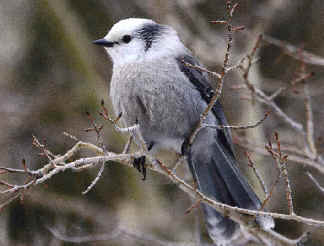
An adult Gray Jay.
Both adults and their young were seen
during our Alaska June 2013 Tour
During our FONT
Alaska Birding & Nature Tour in June
2013 we enjoyed some wonderful bird sightings, including
those of:
both Tufted and Horned Puffins close to us,
rafts of Common Murres on the sea along with many others on their
cliff-side ledges,
clouds of Black-legged Kittiwakes in the air, and also on their
cliff-side ledges,
a male Northern Wheatear singing its song, miles north of the Arctic
Circle,
male and female Varied Thrushes together in a spruce tree,
both male and female Rufous Hummingbirds,
pairs of Barrow's Goldeneye and Surf Scoter on tranquil remote
lakes,
Gray Jays accompanied by their darker than gray young,
and more, including both Bald and Golden Eagles, as well as Pine
Grosbeaks and Pine Siskins, Redpoll and Raven, Boreal Chickadee
and Alder Flycatcher (both outside a window at a place where we
stayed), and both Red-necked and Horned Grebes close to us, as
were both Tundra and Trumpeter Swans.
The last of these, as much as any bird, symbolizes the wilderness of Alaska,
as it fits in so well with the beauty of the vast landscape.
The beauty of the Horned Grebe, in its breeding attire, was truly
something to behold.
A flock of over 20 Harlequin Ducks, males & females, compactly
together, was extraordinary.
And wonderful to see were two Wandering Tattlers, also along a rocky
coast. Those peregrinators were behaving for us as if sometime in their
travels, they had taken the time to read a bird guide themselves. Their
actions were just as the book said they should be, as they bobbed and called.
Calling atop treetops were Wilson's Snipes and Lesser Yellowlegs,
as the book says they do in their nesting areas.
Watching birds in Alaska is fun, even if they are birds that we might
see closer to home, acting differently.
And watching mammals was fun for us too, during our June 2013 Alaska
Tour. Those we saw included:
Brown (or Grizzly) Bear, Moose (even 2 of them walking
about in the parking lot of a place where we stayed), North American
Porcupine, North American Beaver, Barren Ground Caribou, Dall's (or White)
Sheep, Mountain Goat, the little Arctic Ground Squirrel, the big
Humpback Whale, Dall's Porpoise, Harbor Porpoise, Harbor Seal,
Steller's Sea Lion, the Sea Otter (on its back in the water), and
the Hoary Marmot (atop a rocky ridge).
Among the butterflies we saw were the Old World Swallowtail, Western
Tailed-Blue, Arctic White, Red-disked Alpine, and Mourning Cloaks
on an alpine tundra not far from the Arctic Circle.
Among the wildflowers and plants that we saw were Alpine Bearberry,
Labrador Tea, Moss Campion, Arctic Lupine, Wind Flower, and fields
full of Alaska Cotton.
No reptile lives in Alaska, but we did encounter, a few times, an amphibian,
the Wood Frog.
All of the wonderful nature and beautiful scenery that we saw and enjoyed were
from the Seward area in the south, to the Copper
River in the east, and north to the Brooks
Range, well north of the Arctic Circle.
Geographically in the middle of these, perhaps the best of all was the magnificent
mountain known as either Denali or Mount
McKinley, the highest mountain in North America.
Many people during their time in Alaska either do not see that mountain, or
have just a glimpse of part of it, as the weather of the mountains often
covers it with clouds.
But we were so fortunate to see it well, again and again, as we were lucky to have crystal clear days, even in the Alaska Range.
At various times, we saw the massive mountain at a distance, but more than
once we saw it closely. Just about the only way we could have seen it more
closely would have been to climb it, and that we did not do.
In addition to the wondrous nature and the beauty of the land, and the
remoteness of places that most only read about (such as the Yukon
River and Brooks Range), we
also enjoyed during our tour some very fine meals (such as those
with fresh Alaskan Salmon), and some great companionship as we traveled
and had our adventures.
Links:
More about the FONT Alaska USA Tour in June 2013
Lists
of:
Alaska
Birds Alaska Mammals
Alaska Butterflies & Moths
Alaska
Wildflowers & some other Plants Alaska
Marine Life (inc Fish)
Upcoming FONT Birding & Nature Tours in Alaska
![]()
FONT E-News, Volume 23, Number 4
May 5, 2013
Birds during the FONT tour in Ecuador in April 2013
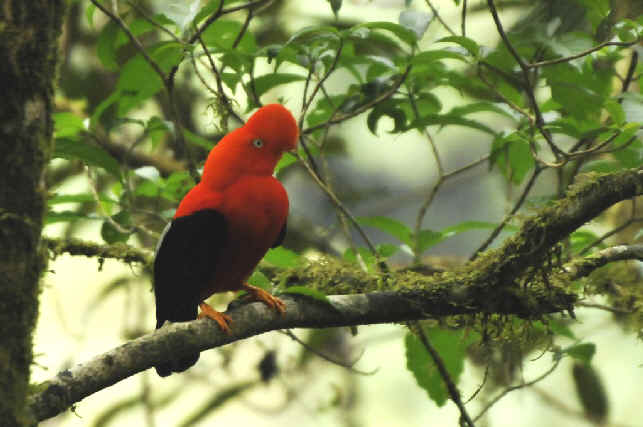
Above: a male Andean
Cock-of-the-rock
And below: a female Andean Cock-of the-Rock
photographed during the FONT tour in Ecuador in April 2013.
(lower photo by Marie Gardner)
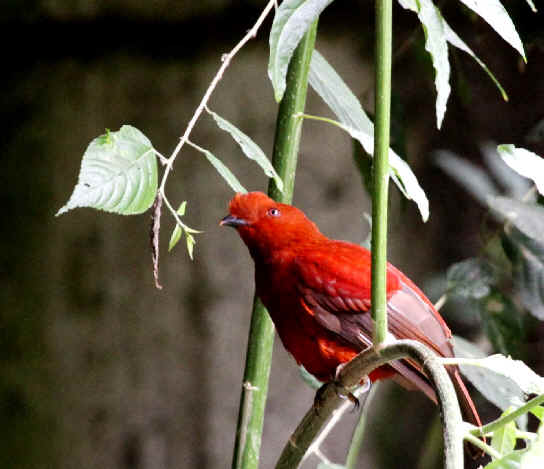
In Ecuador,
during the FONT tour in April 2013, we saw
birds, many of them. Nearly 300 species.
So many were hummingbirds. Over 40 species. Many, with their iridescence, were colorful.
All were fast as they flew. Many were distinctive, some with long tails, and one
with a long, very long bill.
During our April 2013 Ecuador Tour, surely we saw the most hummingbirds ever
seen during any FONT tour,
for both the numbers of individuals and species seen.
And the most antpittas - and among them, a number seen very well,
including the Moustached, Ochre-breasted, Rufous, and Tawny.
Antpittas can be hard to see. As can be tapaculos. During our
April 2013 Ecuador Tour we enjoyed a great look at one of the largest and most
boldly-patterned in that family, the Ocellated Tapaculo.
A spectacular bird, for us, was the Andean Cock-of-the-Rock. We saw a
female before she flew to her nest, and the following morning we encountered a
group of males as they noisily flew about at their lek.
Other birds we saw with the adjective "Andean" included the
rarely-seen Andean Potoo, the Andean Gull and Andean Lapwing,
and the biggest of all, the Andean Condor.
At one time and place, we saw what has been for FONT, the biggest number of Andean
Condors, as many as 21, concentrated on a field apparently partaking in a
meal.
That was an experience in the high Andean mountains of Ecuador never to be
forgotten.
The Andean Potoo was one of two species of potoos during our tour. Twice,
Common Potoos were seen, as still as could be, camouflaged as branches
during the day.
An unusual experience for all of us was seeing another nocturnal bird, the Oilbird,
sitting by day on ledges in a narrow cave-like chasm.
Others in the avian cast of characters during our April 2013 tour in Ecuador,
included a good assortment of toucans, tanagers, trogons, and
manakins, barbets, woodpeckers and woodcreepers, and wrens,
euphonias, conebills, and flower-piercers.
All of the birds mentioned here made, of course, for a great birding tour.
Links:
A Photo Gallery of Birds & Butterflies during the FONT Ecuador Tour in April 2013
A longer Narrative relating to the FONT Ecuador Tour in April 2013
Birds during the FONT Ecuador Tour - April 2013
A
List & Photo Gallery of Ecuador Birds, Part 1 of 4
(with links to Parts 2 to 4)
Rare & Threatened
Birds of the Andes & Patagonia
South American Mammals (with some photos)
A List & Photo Gallery of South American Butterflies, in 5 Parts
Upcoming FONT Birding & Nature Tours in Ecuador
![]()
FONT E-News, Volume 23, Number 3
April 15, 2013
Birds with the Longest Wings & the Biggest Talons
In the Focus On Nature Tours website, among the most popular features,
that continue to receive the "most hits", are those about Rare
& Threatened Birds at various places that we've visited over the years
during our tours.
Spreading interesting information about such species is a good thing, as it
helps, overall, in their conservation.
For a few years, there have been features in the FONT website about:
RARE & THREATENED BIRDS IN THE CARIBBEAN
RARE & THREATENED BIRDS IN JAPAN
RARE & THREATENED BIRDS IN BRAZIL
Now, two new features have been added:
RARE & THREATENED BIRDS IN NORTH AMERICA & MIDDLE AMERICA
RARE & THREATENED BIRDS IN SOUTH AMERICA, IN THE ANDES &
PATAGONIA
In each of these, during the months ahead, more information about the birds
will be added, but already there are some interesting things to read.
For example:
About the birds with the longest wings, in the new feature about
the Rare & Threatened Birds in the Andes & Patagonia,
click the link for the Wandering Albatross (in the
"vulnerable species" category).
And about the bird with the biggest talons, in the feature about the Rare
& Threatened Birds of Brazil, click the link for the Harpy
Eagle (in the "near-threatened species" category) and scroll
down to the photo of the talons.
In the new Rare & Threatened Birds of North America & Middle
America, you can read about the Turquoise Cotinga and Alexander
Skutch, the late renowned naturalist in Costa Rica. The Turquoise Cotinga link
is in the "vulnerable species" category.
Also in that same feature with North & Middle American Rare &
Threatened Birds, one can read about the Red Knot, a migratory bird
that is now, if you are reading this in April, starting its migration north
from southern South America.
Click the link for the Red Knot in the "endangered subspecies"
category.
In that narrative, not only is there a lot of information about the Red
Knot, but also referred to is the Yellow Cardinal (rather than the
red one), and a place in southern Argentina where that Cardinal lives, near
where the Knots occur.
That place is the farm of Senor Manana. Yes, it's true. We've been
there, and we'll be going again during our tour in Southern Argentina,
in late 2013.
While referring, here, to that migratory shorebird, the Red Knot, it's
also noteworthy to say that Birdlife International, the organization
that keeps track of what's rare and threatened (critically endangered,
endangered, vulnerable, and near-threatened), has recently added the
Semipalmated Sandpiper to the list, as a "near-threatened
species".
it is a species that those of us who have birded for a while have considered
plentiful, far from threatened.
But it is now a species in our North & Middle America Rare &
Threatened Bird List. Not that it's rare yet, but certain recent
population trends and indicators are not good.
Another interesting piece in the Rare & Threatened Birds of North
America & Middle America relates to an annual "Mountain
Plover Festival" in a small, in fact a very small town in Colorado.
There is so much of interest relating to birds.
And to mammals too. One of our highest ranked website files is that of
SOUTH AMERICAN MAMMALS
While typing the names of those species into that listing, I couldn't help but
be intrigued as to how a couple got those names:
the Intelligent Grass Mouse, and the Tail-less Tailed Bat.
Now, those two creatures I'd like to see some day.
I hope you visit our website features, such as those noted here, to see about
such nature in the world, and to take a look at our upcoming scheduled
tours to see birds and other nature, rare and otherwise.
All the best,
Armas Hill
![]()
FONT E-News, Volume 23, Number 2
March 4, 2013
Rare Birds and a New Bird now Named
First, the new bird:
Seen during a FONT tour in Chile, in December 2009, from the ferry to
Chiloe Island, what was then a "mystery storm petrel" has since been
described as a new species. And it has now been named:
the Pincoya Storm Petrel, Oceanites pincoyae
For more about it: NEW CHILE STORM PETREL
Now, the rare birds:
This past year, in 2012, according to the organization, based in the
UK, known as Birdlife International (a source of much good
information):
Of the 10,064 species of birds in the world, 1.313 were classified as
"threatened species".
In that group there are 3 further classifications, with species that are:
1) critically endangered
2) endangered
3) vulnerable
And there's another grouping of "near threatened species".
This past month, in February 2013, Armas Hill of FONT gave presentations
in Maryland and Pennsylvania about some of these threatened and
near-threatened birds of the world.
In his program entitled "Birds on the Brink", there were some
birds that are now on the brink of extinction, and others that have been there
""on the brink"" and are now doing better.
Armas is pleased to give such a program to interested groups, whether it be a
club or organization, or any group that may what to learn about and view
photos of some of the rarest and most interesting of birds.
FONT has had 3 printed booklets (for distribution) and corresponding website
files about:
RARE BIRDS OF BRAZIL (one of the three countries in the world with the most threatened bird species)
RARE BIRDS OF JAPAN
And now there is a fourth booklet, and website file:
RARE BIRDS OF NORTH AMERICA AND MIDDLE AMERICA, SOUTH TO PANAMA
In it (as of now), there are 132
species of birds, plus 3 subspecies, along with 9 species
now believed to be extinct.
Here's a bit of a breakdown:
57 species in North America (including the US and Canada)
17 species in Mexico only
25 species in Central America (including Mexico & Middle America)
24 species in Middle America (from Guatemala & Belize south to Panama)
13 oceanic species
In the new booklet, or website file, you can see which of the species are
categorized as:
critically endangered (4 of them), endangered (18 of them),
vulnerable (50 of them), near-threatened (59 of them).
More is yet to be added, but now in that file (reached from the link above)
you can scroll down and read interesting things about birds such as:
California Condor, Spoon-billed Sandpiper, Cozumel Thrasher, Horned Guan,
Gunnison Sage Grouse, Black-capped Petrel, Whooping Crane, Azure-rumped
Tanager, Greater and Lesser Prairie Chickens, Short-tailed Albatross. Bristle-thighed
Curlew, Marbled Murrelet, Turquoise Cotinga, Bicknell's Thrush, Cerulean
Warbler, Rusty Blackbird, Harpy Eagle, Corn Crake, Mexican Sheartail (a
hummingbird), Kirtland's Warbler, and these now either known or believed to be
extinct:
Atitlan Grebe, Eskimo Curlew, Great Auk, Ivory-billed Woodpecker, Bachman's
Warbler.
To
Top of Page